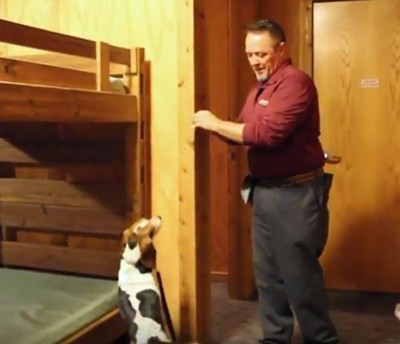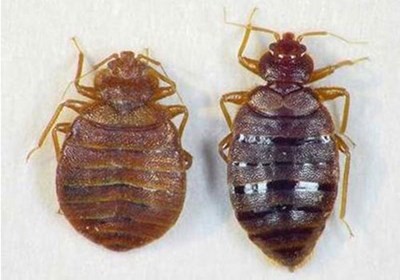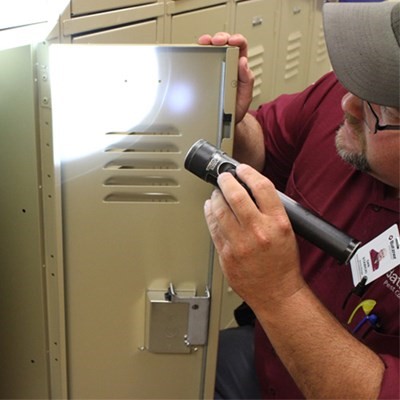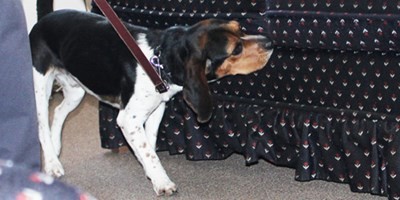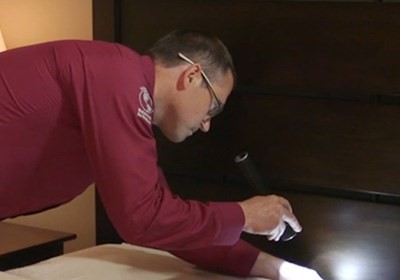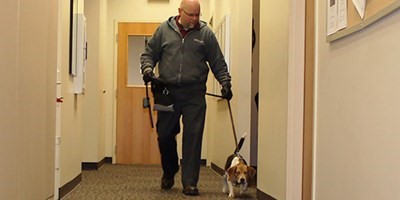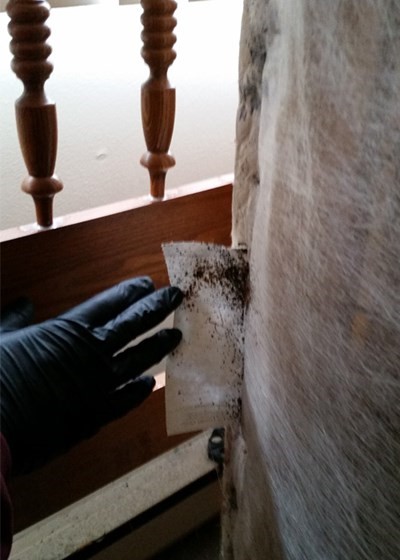Proactive sweeps cut down on heavy infestations by allowing Batzner to detect and treat a problem early on, reducing the chance of it spreading to more areas of the building. The proactive approach is a cost-effective way to handle bed bugs in multi-unit properties and high-traffic areas. Watch as Glen Bishop, Batzner’s Certified Canine Handler, demonstrates a proactive canine sweep with his dog, Lucy.
Bed Bug Facts and Information for Prevention
Bed Bugs are a very real problem in the United States. According to a survey conducted by the National Pest Management Association, 1 in 5 Americans has had a bed bug infestation in their home or knows someone who has.
In the pest control industry, we answer countless questions about bed bugs and consider ourselves “myth busters” when it comes to the tiny, blood-sucking pests. Knowledge is your first line of defense. Simply knowing how to correctly identify a bed bug and its basic behaviors goes a long way in preventing an infestation.
Basic bed bugs facts:
- Bed bugs primarily feed on humans, but they also feed on warm-blooded animals, including birds, mice and pets.
- Adults are just under ¼” long, relatively flat and oval in shape compared to most other insects.
- Bed bugs can lay one to five eggs per day and more than 500 in a lifetime.
- Bed bugs can survive for several months without eating.
- Bed bugs can withstand a wide range of temperatures, from nearly freezing to 122 degrees Fahrenheit.
- Bed bugs draw blood for about five minutes before retreating to digest.
- Bed bug hatchlings are so small they can pass through a stitch-hole in a mattress.
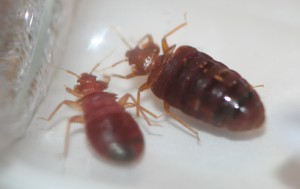
Now that you’re thoroughly disgusted, let’s move on to how you can protect yourself. While there is no 100% guaranteed way to prevent bed bugs, there are steps you can take to greatly decrease your chances of bringing them home.
It’s important to keep in mind that bed bugs can be found nearly everywhere. Hotels, movie theaters, apartment complexes, libraries, public transportation, retail stores, and even offices can all harbor bed bugs.
Quick tips to help keep you bed bug free:
- Regularly inspect sleeping areas for signs of bed bugs such as pepper-like stains, molted bed bug skins and white, sticky eggs.
- Never bring second-hand furniture, especially mattresses and box springs, into a home or college dorm without thoroughly examining it for signs of a bed bug infestation.
- At hotels, thoroughly inspect the entire room before unpacking, including behind the headboard and in furniture. Pull back the bed sheets and check the mattress seams for pepper-like stains that may be evidence of bed bug activity. If you suspect an infestation or problem, notify management and change rooms immediately. Be sure the new room is not adjacent to or directly below or above the possibly infested room.
- Keep suitcases in plastic trash bags or protective covers during a hotel stay to prevent bed bugs from nesting there. Do not put them on the beds.
- Upon returning home from a trip, inspect all suitcases and other belongings before bringing them into the house.
- Wash all clothes – even those that have not been worn – in hot water and dry them using an extra-hot dryer setting.
If you suspect or discover a bed bug problem in your home, it’s best to contact a professional right away. Attempting self-treatment can often do more harm than good.
Where are Bed Bugs Found? 6 Places You Wouldn’t Expect to Find Bed Bugs
Bed bugs have the physique that allows them to hide under, behind, and in anything. They will typically hide within five feet of their food source, which correlates with where you spend most of your time, likely where you sleep.
Bed bugs are found in many places, not limited to any one specific type of dwelling. Infestations have been reported everywhere including single family homes, multi-family housing, apartments, hotels, hospitals, schools and college campuses, office buildings and even retail stores. Even five-star hotels and high-end clothing stores are susceptible to infestations. While there are the typical places bed bugs are found, they might be found in a few unlikely places as well, including:
- Movie theaters
- Waiting areas – doctor’s offices, government buildings, office lobbies
- Libraries
- Public Transportation – buses, taxi cabs, trains
- Locker rooms
- Airplanes
So how do they get to these unlikely places?
Steve Counsell, Training and Development Manager, explains, “Female bed bugs are the most likely to hitchhike, which causes trouble for us. If the female is pregnant, she is bringing with her a bunch of potential little bed bugs. Pregnant females will typically migrate away from the bed to unusual places throughout a room.” From here, they are likely to get picked up by accident and transported to one of the places listed above.
It is important to remember no place is a guaranteed bed bug free zone. Any place humans sit, rest or sleep gives bed bugs the opportunity to feed and multiply. In order to protect yourself as best as possible, inspect public areas before you take a seat or set down your belongings.
Prevent Bed Bugs from Coming Home from College
If your child is a college student visiting home for the weekend or moving home for the summer, you should be conscience of protecting your home from bed bugs. They hitch rides to and from campus along with your kids. College dorms and apartment complexes are hot spots for bed bugs. College housing can be prime territory for bed bug infestations to spread rapidly, and it only takes a few hitchhikers on your son or daughter’s belongings to bring that infestation into your home. If you have a child in this position, make sure they aren’t bringing any unwanted guests back with them.
Because bed bugs are excellent hitchhikers, they are easy to carry both to and from campus. Here are a few tips on bed bug prevention in college dorms and apartments:
- Suit cases and trunks should be fully inspected for signs of bed bugs prior to using for back to school packing, especially if they were used for other travel.
- Any secondhand or rental furniture should be inspected to ensure that it is free of any bed bugs or bed bug evidence.
- Dorm rooms should be inspected prior to unpacking – begin with the mattress and check any additional furniture in the room, such as sofas or chairs.
- Invest in a mattress encasement if your school doesn’t provide them. While a mattress encasement can’t stop bed bugs from getting into your dorm room, they can allow you to see bed bugs that get introduced to your room, since it prevents them from being able to hide on the mattress and box spring. Look for an encasement that promotes “bug proof” zipper locks.
Randy Rupert, Batzner’s Bed Bug Team Leader, recommends the following to prevent the transfer of bed bugs while moving. A visual inspection before packing is always necessary.
- Look out for blood spots on linens and clothes
- Check for fecal spotting on and inside the box spring and box spring frame
- Inspect area around bed for shed skins, eggs, and live bugs
If you find any reason to believe that bed bugs are present, or if you just want to be extra careful:
In the Dorm
BAG EVERYTHING, especially linens, clothes, and shoes and securely tie the bag(s).
At Your Home
Leave the bags/luggage in the garage, complete the following steps before bringing anything inside (if possible)
- Empty the bag as soon as possible
- Put contents into the dryer right away, dry for 30 to 60 minutes on HIGH
- Keep an eye out for black spots in seams, dust skirts, fitted sheets, and other places bed bugs like to live
- Vacuum all the luggage, bags, etc. as well as the around the bags/luggage
- Wash canisters and other transferring material that cannot be vacuumed
- Wipe down hard surfaced items (laptops, TVs, etc.)
Moving day from a college campus can be a tiring, frustrating experience, but these few extra steps are very much worth the effort. Bed bugs in your home are a sure way to ruin what should be an enjoyable time with your child! If by some chance a bed bug infestation still occurs, or if you have any questions on bed bug prevention or management, don’t hesitate to call 866-591-3519 or contact us online.
Bed Bug Protocol for Apartments, Hotels, and Hospitals
If you manage an apartment building, hotel, hospital, or any other multi-unit complex, knowing how to handle bed bugs is an absolute necessity. All it takes is one infested piece of luggage, furniture, or clothing entering your building for an infestation to take hold and spread to multiple units.
If a tenant or guest gives any indication that bed bugs are present, you can do a quick visual inspection, looking out for the bugs themselves and small dark spots on sheets, in the seams of mattresses, and on bed frames and headboards. If any sign of an infestation exists, call a professional bed bug service provider immediately!
Batzner’s Bed Bug Treatment of Multi-Unit Complexes Consists Of:
1. Inspection of unit reporting the issue (K-9 recommended).
2. Inspection of adjacent units, even across the hall (K-9 recommended).
3. Questioning of tenant:
– Have you traveled?
– Have you bought any used furniture?
– Have you had any guests over recently?
– Do you frequent other units or common areas?
– Have you self-treated? (this can disrupt our own inspection and treatment)
4. Treatment by either chemicals or heat, depending on the situation.
5. Follow-up and final inspection.
Cooperation between the manager, tenant, and Batzner is vital for success in dealing with bed bugs. We will work with you every step of the way to make sure you know exactly what we are doing to fix your problem, just contact us at the earliest sign of infestation!
Benefits of Using Scent Detection Dogs for Bed Bug Inspections
Summer are some of the busiest days for our bed bug scent detection canines. As the weather heats up, the summer travel season starts to pick up, inevitably leading to an increase in the spread of bed bugs. Since bed bugs are hitchhiking pests, they’re bound to spread the more people are on the move. The small nuisance critters will clasp on to clothes, luggage and other personal belongings, allowing them to go wherever their human taxis are headed. Once someone brings these pests home, it’s time for the Batzner bed bug scent detection dogs and their canine handlers to confirm suspected bed bug infestations. Our dogs are trained to only alert to live bed bugs and viable eggs.
Why You Need a Bed Bug Dog Inspection
Using canines to perform a search for bed bugs is efficient when several areas or rooms require inspection because it is less time consuming than humans searching. Using their incredible sense of smell, canines are able to detect and find live bed bugs within minutes of searching. Despite their name, bed bugs don’t limit themselves to bedding. These pests conceal themselves in the depths of furniture, in upholstery, behind wallpaper and baseboards, inside walls, and behind outlets, light switches, and cable and phone jacks. Their ability to hide makes detecting them quite a challenge. In fact, humans can uncover a low-level infestation just 30 percent of the time. That’s why so many people are turning to dogs for help.
Benefits of Bed Bug Sniffing Canines
- The keen sense of smell in dogs makes them experts on bed bug detection with a very high percentage of accuracy. They can detect live bed bug scents through mattresses, inside walls and furniture. While bed bugs may lurk in nooks and crannies that are out of sight of humans, they cannot hide from a dog’s sensitive nose. Thanks to their keen affinity for scent, dogs can literally sniff out the presence of both bed bugs and their eggs.
- In addition to accuracy, bed bug canines are extremely fast and efficient. Bed bug canines can easily find the areas where bed bugs reside, and detect them quicker than their human counterparts. Faster detection can speed up the treatment process and allow you to get back to business as usual. Large hotels can be covered in a fraction of the time it takes to complete a visual inspection, giving owners peace of mind that the facility is free of bed bugs.
Who Are These Dogs & How Are They Selected?
There are several training facilities, mostly located in Florida, which raise and train dogs to detect the presence of bed bugs. Dogs rescued from local shelters are mainly used and are chosen based on their breed and level of energy. The most successful dogs are highly energetic and contain biological traits that improve their sense of smell. In addition, the dog must have a solid work ethic and the ability to maintain focus while on the job.
Training the Canine
Usually canines start training between eight and twelve months old, but depending on the age when they are rescued, it can vary. To be eligible for certification, the dog must complete between 800 and 1,000 hours of training. Training takes place in specialized facilities that provide realistic situations and natural hiding places bed bugs. The dog will be exposed to the bugs in their different life stages in order to learn the varying scents of each stage. It is important for the dogs to be able to distinguish between live bugs and dead cells because a false positive could lead to unnecessary treatments and expenses. A canine should not identify past infestations that are no longer a threat. The handlers go through just as much training as the dogs. Both must be a good match for each other in order to pass the certification test.
Scent Detection Certification
Once the training hours are completed, the dogs must be certified by NESDCA. In order to become fully certified, canines and their handlers must pass the certification requirement together. If the canine is ever transferred to a new handler, the certification must be passed again as a new team. A single dog cannot be legally certified without a handler, and vice versa.
The Testing Process
Accredited judges from NESDCA will evaluate the canine and handler through a number of tests. The canine is evaluated on detecting the presence of bed bugs and his or her ability to discriminate between scents. The dog passes the test by making a motion toward the source of the scent, such as pawing or pointing with its nose. The handler is evaluated on their ability to control, command, and work with the dog. Certifications are valid for a full year for the specific scent that was tested.
Are Canine Services Cost-Effective?
Since many residents and business owners spend thousands of dollars on infestation removal, there are concerns that the use of scent detection dogs is just another added expense. However, the use of bed bugs dogs can save an individual or company several thousands of dollars on unnecessarily treating rooms that are not infested. Because of their accuracy, a bed bug canine team can identify one bed bug just as easily as it can detect a severe infestation. Early detection saves time and money before infestations can get out of control.
If you find yourself dealing with a potential bed bug issue, it might be time to call 866-591-3519 or contact the four-legged bed bug canines at Batzner!
How to Check for Bed Bugs and Avoid Hotel Bed Bugs While Traveling
Many people take trips during the holiday season and the summer months, which unfortunately means that a lot of bed bugs will be traveling as well. Bed bugs are excellent hitchhikers, and they love environments with lots of people in close proximity. Because of this, certain locations that are very likely to be a place of departure or arrival, such as college dormsand hotels, have a high risk of bed bug infestations. Relatives’ homes are not guaranteed to be safe from bed bugs either, especially those with residents or other guests who have also been traveling.
Luckily, there are some steps to reduce your risk of giving bed bugs free rides and meals while traveling. The National Pest Management Association recommends the following steps for travelers.
Upon Your Arrival
Bed bugs are least likely to be found in the bathroom, so before you settle in for the rest of your trip, place your luggage there until you’ve had a chance to make sure the coast is clear. Check the following:
- Thoroughly inspect the entire room you are staying in with a flashlight before unpacking, including behind the headboard, under lights, and inside dressers, drawers, sofas and chairs.
- Pull back the sheets and inspect the headboard, mattress seams and box springs, particularly at the corners, for telltale stains, spots or shed bed bug skins.
- Signs of bed bug activity can include small, white translucent eggs, cast skins and inky-dark fecal stains on the mattress.
- Look for little dots of blood or black specs that look like mold or ground pepper.
- Keep your eyes peeled for the bugs themselves. They are about the size of an apple seed and you might find them in corners or the seams of bedding.
- If you notice bed bugs in your room, notify management and request to change rooms immediately. Be sure the room is at least two floors away, since the bugs may travel through wallboards and electrical sockets.
During Your Stay
- Keep your luggage off of the ground.
- Place suitcase in a plastic trash bag or large zip up bags (available from luggage or travel retailers specifically for this purpose) during the duration of your trip to ensure that bed bugs cannot take up residence there prior to departure. *Tip: Pack clothes in zip lock bag for easy cleaning upon returning home.
- Do not place luggage on upholstered surfaces. The safest place is in the bathroom in the middle of a tile floor or on a luggage rack after it has been thoroughly inspected. Do not use a luggage rack if it has hollow legs, where bed bugs may hide unseen.
Upon Your Return
- When you return home, inspect your suitcases before bringing them into the house.
- Vacuum your suitcase thoroughly before bringing indoors and storing away.
- To remove any bed bugs or eggs that may have traveled home with you, place all clothes in the dryer on high heat for at least 30 minutes, even those items you haven’t worn. Then wash all clothes in hot water. Dry clean only clothes should be thrown in the dryer and run on high heat.
***If you do find bed bugs upon your return home, we DO NOT recommend using do it yourself treatments. These products often do not take care of the entire infestation and can potentially cause the bed bugs to scatter throughout your home, making them harder to get rid of in the long run!***
Although an inspection of your hotel room is probably the last thing you want to do when checking in after a long day of travel, doing so, along with cleaning your items when you return home, can save you the misery and expense if you brought bed bugs into your home.
Having someone knowledgeable on the subject is extremely reassuring when an infestation occurs, so brush up on your bed bug knowledge here. Remember, no one wants to gift or receive a bed bug infestation, so spread the word and make sure your family and friends are vigilant when traveling! Call us at 866-591-3519 or contact us online if an infestation occurs; you can always count on Batzner.
How to Prevent Bed Bugs in Schools and Avoid Bringing Them Home
Bed bug infestations with sustaining populations in classrooms are rare because schools are generally poor environments for bed bug survival and reproduction. However, periodic introductions of bed bugs into classes occur more often due to the increasing frequency of bed bugs in homes.
Bed bugs can crawl onto or off of a person, or their belongings, at any time making them excellent hitchhikers. In fact, the most common way for bed bugs to enter a school is through “hitchhiking” from an infested site. Usually this is from a student, staff or teacher’s home which has a bed bug infestation. Bed bugs are not associated with uncleanliness or socioeconomic status, but this insect has a substantial social stigma. While teachers and staff can be more easily addressed, dealing with students or parents can be challenging, especially if the family cannot afford proper control measures or their landlord refuses to properly treat their home.
Steps schools can follow if a student’s home is known to have a bed bug infestation:
- Provide the student with educational materials they can take home with them.
- Send a letter to the student’s parent or guardian requesting that they take steps to reduce the risk of bed bugs being transported to school.
- Send a letter to all parents with children in the affected classroom.
- Provide the student with plastic bags or a plastic bin in which to store their belongings while at school.
- Isolate the student’s belongings.
- Reduce the number of items that the student has to transport between school and home.
- Regularly inspect the student’s desk and or locker for bed bugs.
- Avoid accumulation of clothes, shoes and boots in the classroom.
Preventing Bed Bugs in the School:
Providing proactive bed bug education is the best way to prevent a bed bug infestation in schools.
- Provide educational materials to staff and parents/guardians.
- Keep the facility clean and uncluttered. Bed Bugs are not associated with uncleanliness, but a clean facility makes it easier to detect bed bugs before an infestation gets established.
- If children take naps at school, regularly put the bedding in the dryer on a high setting for at least 30 min. This will kill all stages of bed bug development. Dress up clothes or theater costumes should also be regularly put through the dryer.
- Regularly clean and inspect the following: lost-and-found, sleeping areas, upholstered furniture, and wall mounted items (pictures, clocks, signs, mirrors, etc.).
- Store items (bedding, clothes, coats, bags) in clear plastic containers when possible.
- Consider periodic inspection by a bed bug detecting canine, if bed bugs are consistently an issue in the population you serve.
Recommendations for parents to follow at home:
- Parents should regularly inspect their children’s belongings for hitchhiking bed bugs.
- Limiting the number of items children bring home from school.
- Regularly checking backpacks, jackets and clothing after kids return home and keeping these items in a separate area of the house.
- Wash and dry cloth items returning from school in hot temperatures.
- Inspecting your car for signs of bed bugs, like shed exoskeletons and blood stains.
- If the school has reported an infestation, consider housing all related items in a sealed plastic bin.
- Ask school administrators whether they have bed bug detection and elimination plans.
Whether your kids are in school or you work in a school yourself, it is important to keep yourself educated about bed bugs and prevention.
Get more information on bed bugs here.
Proactive Bed Bug Control Using Bed Bug Sniffing Dogs in Hotels, Apartments, and Hospitals
Be Proactive About Bed Bugs; Implement Our Regularly Scheduled Canine Inspections!
Brenda Borgman, Batzner’s Account Executive Manager, sums up the benefits of proactive bed bug canine inspections: “Doing proactive sweeps cuts down on heavy infestations by allowing us to detect and treat a problem early on. This reduces the chance of it spreading to more parts of the building, which can be expensive and a hassle for owners and managers to deal with. Overall, the proactive approach is a much more cost-effective way to handle bed bugs in multi-unit properties.”
Difference between Inspections and Treatment
What are proactive bed bug sweeps? By contracting to have bed bug sniffing dogs come in at regular intervals, bed bug problems are caught before they are able to take hold and spread into a full-blown infestation. The cost of proactive inspections compared to the steep cost of eliminating heavy infestations multiple times means they pay for themselves.
Frequency of Inspections
The frequency of these inspections is determined by the clients’ needs. For college dorms this is often just once a year before the fall semester or twice a year in the fall and during the winter break. Other properties, such as apartments, hotels, hospitals, and social service training facilities require more frequent visits, usually quarterly but sometimes monthly.
How Proactive Inspections Work
Our highly-trained Bed Bug Canine Team performs sweeps of critical areas where bed bugs are likely. In dorms, apartments, and hotels, this covers the rooms, hallways, and lobbies where there are many people coming and going, with particular focus paid to the bed area and furniture where a tenant/guest might be sleeping. Similarly, in social service and healthcare facilities, the waiting areas, training areas, and emergency rooms are considered critical areas due to the amount of people going in and out who are potential carriers for bed bugs.
Remember, early detection is the key to preventing bed bugs from becoming a major problem. Randy Rupert, our Bed Bug Team Leader, adds that, “In addition to the cost saved by avoiding multi-unit infestations, preventative canine inspections’ high detection rate provides property owners and managers peace of mind that bed bugs won’t be shutting down their business.”
Learn more about our bed bug Canine Team!
Call 866-591-3519 or contact Batzner online today for more information about our proactive canine inspections!
How Do I Know If I Have Bed Bugs? Learn About the Signs of Bed Bugs
It’s no secret that bed bugs are seriously creepy creatures. After all, they like to live near your bed and feed on your blood while you’re sleeping. Disturbing, right? If you think you may have bed bugs, you should look in two places for evidence: on your body and in your room.
Bed Bug Evidence on Your Body
The primary sign of bed bugs on your body are red, itchy bites, usually appearing on skin that’s exposed while sleeping. Bed bug bites are often mistaken for mosquito bites or bites from other insects, and some people show no reaction at all to bed bug bites. So it’s no wonder they go undetected for long periods. Bed bugs might be present if you are waking up with bites you can’t explain. The biting pattern is usually in straight rows, unlike the sporadic biting of other insects. Also look for:
- Raised, red welts
- Burning and itching
- Bed bug bite rash across localized area
Bed Bug Evidence in the Room
Bed bugs are clever enough to hide during the day but leave behind the evidence of their blood-thirsty crimes. Their carelessness is one of the best indicators your room is overrun with bed bugs. You will often see evidence of a bed bug infestation without actually seeing any bed bugs. Below are secondary signs you can look for.
- Fecal stains in the areas they inhabit
- Fecal spots will not flake off if rubbed and will smear if wiped with a wet rag
- Fecal stains will be black due to the digested blood that is excreted
- Rusty or reddish stains on bed sheets or mattresses caused by bed bugs being crushed
- A clear bed bug shell, or exoskeleton, which is shed as the bed bug grows larger
- A live bed bug
I Have Evidence of Bed Bugs, But How Do I Find Them?
Bed bugs hide in a variety of places when they are not feeding. If you know the right place to look, you may be able to spot bed bugs. Adult bed bugs can be seen with the naked eye. Their favorite spots include around the bed, near seams and tags of mattresses and box springs, and in cracks on the bed frame and headboard. If the room is heavily infested, bed bugs may be found in these additional places:
- In seams of chairs and couches, between cushions, in the folds of curtains
- In drawer joints
- Under loose wall paper and wall hangings
- In electrical outlets and appliances
- At the junction where the wall and the ceiling meet
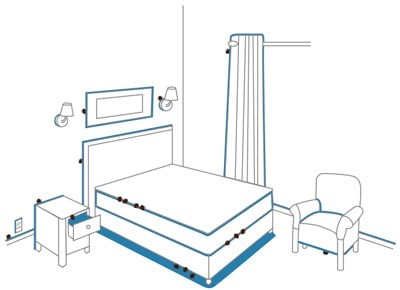
If you think bed bugs have invaded your home, call 866-591-3519 or contact Batzner online today! Our team of specialists will discuss treatment options and recommend the right plan for your property. Sleep well again and get all the beauty rest you deserve.

